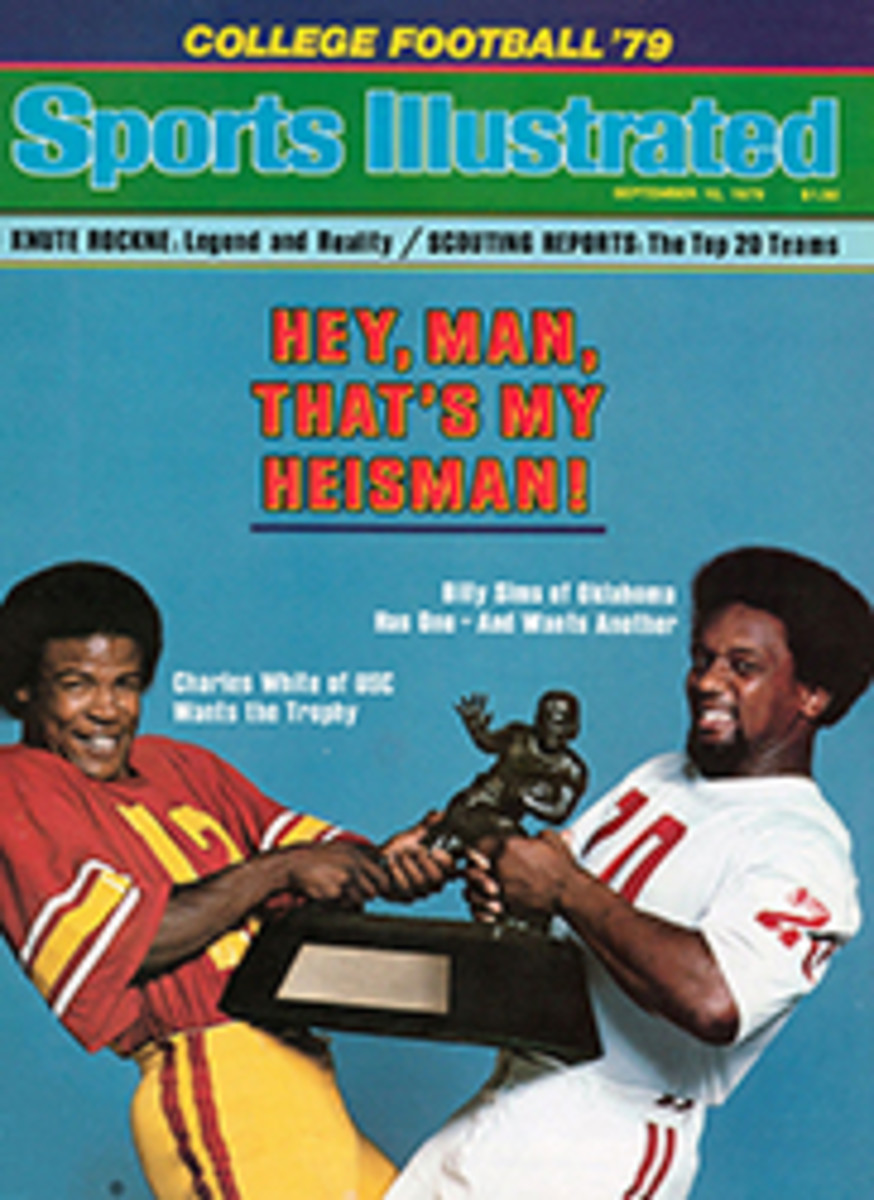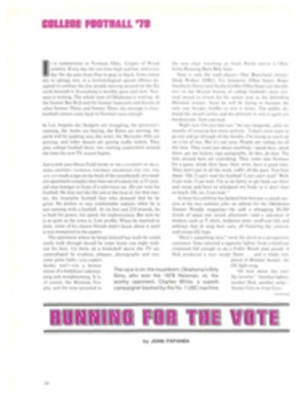
OH, NO, NOT AGAIN!
In another context, in another ball game, you would have laughed at such a play. The people who put together NFL Films might have sped it up and played some tinkly music in the background, and everyone might have smiled—until they saw the aftermath. In the final frame would be Bert Jones, the Baltimore Colts' superlative quarterback, lying on the Tartan Turf in Kansas City's Arrowhead Stadium, grabbing his damaged right shoulder. Jones is one of the two indispensable players in the NFL. The other is Houston's Earl Campbell. They can change the whole complexion of a team, lift the people around them—the hopes, the record, everything. They are franchises.
On Sunday afternoon Jones went down on a Looney Tunes play late in the third quarter of the Colts' 14-0 loss to the Chiefs. Later, in the losers' locker room, Baltimore Coach Ted Marchibroda, whose natural expression is worry, stared at the floor and said, "I just don't know. The kid tried to come back and go some more, and he just couldn't do it." Marchibroda shook his head, and somewhere in there was a vision of 1978, when he tried to get through most of a season—a very long 5-11 season—without Jones. With Jones, the Colts had been a playoff team in 1975, '76 and '77. Without him in 1979? "You can't rush a thing like this," Marchibroda said.
And then Dr. E.J. McDonnell, the Colts' orthopedic surgeon who spent his off-season telling people that the separated shoulder that had sidelined Jones for 13½ games in 1978 was "rehabilitating very well," said of Jones' latest injury, "It's a severe contusion. It's going to stay sensitive for a long while. Terry Bradshaw had a separated shoulder. A lot of them have had it. The question is: Can they stand the pain?"
The pain in Jones' shoulder—and the pained look on Marchibroda's face—was caused by a flea-flicker that flickered briefly and then died. It was doomed from the start. Jones, his team down 7-0, was desperately trying to get something going, so he turned to one of the few trick plays in the Colts' playbook. Marchibroda is not a gimmicky coach. His offense is very basic, some say conservative. Hammer away with what you do best, or as Marchibroda puts it, "Everything within the context of your personnel."
At Kansas City, that meant going almost exclusively to one of the few healthy weapons in a Colt uniform, little Joe Washington, the halfback. Swing the ball to Washington, pitch it to him, hand it off to him—and hope for a miracle. Washington was having a big day, but the Arrowhead scoreboard still said Chiefs 7, Colts 0.
So, on first down at his own 36, Jones dished off another swing pass to Washington, and the plan was for Joe to flip the ball back to Jones who would hit somebody breaking downfield. Washington slipped, then one-bounced his toss back to Jones, who fielded it neatly on the short hop. "Pretty good shortstop, huh?" Jones would say. He flung the ball downfield where Mack Alston, a tight end who earns his living as a blocker, was standing side by side with Linebacker Thomas Howard. Howard stepped up for the interception, so Alston wrapped him up—like a lifeguard wrapping a blanket around an exposure victim. The referee's flag went down for offensive interference. Laughter from the stands.
Back upfield, Jones was down on the rug—and in agony. Sylvester Hicks, a 6'4", 252-pound defensive end, had put a rush on Jones, and the top of his helmet struck Jones' right shoulder—the shoulder that had been separated. Suddenly Greg Landry was in the game at quarterback for the Colts. But four plays later Jones returned.
Jones has a history of coming back and trying to work out his injuries under battle conditions. When the Steelers banged up his arm in the '75 playoffs, he came back in the fourth quarter and marched the Colts 85 yards, only to see the drive die on the three-yard line. When Jets' Linebacker Bob Martin re-separated Jones' shoulder last Oct. 15—it had originally been injured against the Lions on Aug. 26th—the quarterback gamely tried to continue for half a dozen plays before he packed it in. And then there was the Washington game last November, the great morality play on Monday night, when Jones went reeling to the bench after three Redskins nailed him on the sidelines. Jones soon reentered and, with three minutes to play, threw the winning TD pass to Roger Carr. That heroic performance prompted some very hard words from Redskin Coach Jack Pardee, words to the effect that perhaps Jones was faking it a bit.
"I don't know why he'd want to say a thing like that," Jones said last week. "Sure I was hurt by what he said, wouldn't you be? I remember throwing one pass to Carr that felt perfect but fell 15 yards short. Sometimes the ball flew on me, sometimes it died, but I'll tell you something, I love this game, and if I can play, I'll play. I guess, in retrospect, it was a stupid thing for me to do."
So, in Kansas City, Jones came back after Hicks' hit and tried a couple of plays. He handed off to Don McCauley, he swung a pass to McCauley that fell short. And then he came out for good.
And now the Colts must be wondering just what the future holds for them. Their long-ball threat, Carr, missed most of camp because of a pulled muscle and had to come out at the half on Sunday because his timing was off. Their tight end, 6'6", 238-pound Reese McCall, was lifted at the half, after dropping a sure TD pass in the second quarter. And now their 28-year-old quarterback—the franchise—has an iffy shoulder again.
"When Bert came off the field, I could see he was in a lot of pain," said Trainer Tim Kirschner. "I put the shoulder through a range of motion. It hadn't been separated again, the ligaments hadn't been torn. He threw a few balls, and they seemed to have a lot of zip. Then he went back in and he couldn't throw, so that was it. We iced it down. Look, it's a long season—15 more games."
Jones now was sitting in the hall, next to the stadium elevator, watching Middle Linebacker Ed Simonini get his sprained knee X-rayed. Jones' shirt was off; the shoulder showed an ugly red bruise, some swelling, but there was no sign of a step deformity, the drop that denotes torn ligaments.
"It's the rotary motion," Jones said. "I could throw as well as I wanted to, but on the follow-through it felt like someone stuck a knife in my shoulder."
"What do you think, kid?" Kirschner said, staring at Jones' shoulder.
"I think it ain't all that bad," Jones said.
"Could you believe that game today?" he said. "We get down deep on our first drive and then we fumble. In the second quarter, we're down on their 14, and the kid [McCall] drops the touchdown. Then I've got McCauley in the corner, I mean he's beaten his man clean, and a lineman [6'7" Art Still] deflects the ball and they intercept it. Penalties. Holding penalties. So many mistakes. Someone told me we set a club record for penalties, is that right?"
He was informed that 14 penalties was indeed a club record. "Every play was called at the right time," Jones said. "I've never felt so confident about plays in a game. Every one was the right play. We just had so many mistakes."
Actually it was a very strange game plan that Jones and the Colts brought into Kansas City. It was an NFC-style plan, with Fran Tarkenton, as played by Jones, dumping the ball off to Chuck Foreman again and again and again, the Foreman in this case being Washington. It was a dump-off offense. It wasn't the kind of attack that's geared to one of the strongest guns—Jones' right arm when healthy—in the NFL. Perhaps the Colts' strategy was dictated by the lameness of their receiving corps, but it was a very risky way to travel. And it's hard to believe that Washington's 5'10", 183-pound frame can go 16 weeks surviving the punishment this offense will inflict on him.
Jones and Landry threw 43 passes. Nineteen were to Washington, who caught 13 of them, tying Lydell Mitchell's club record. In practice one day last week Mike Siani, another of the crippled Colt receivers, was watching Washington put a fake on a linebacker. "What a weapon," Siani said. "He could wind up catching 100 balls this season."
Wrong projection. Multiply Washington's 13 catches on Sunday by 16 weeks and you've got 208 catches, which might make the Guinness people stand up and holler—and brighten Washington's offseason in his hospital room.
Colt runners carried the ball just 22 times against Kansas City, not counting three scrambles by Jones and Landry. Washington was the man on 16 of those carries. And all this time, while the Colts were praying that little Joe would somehow, some way, manage to pop one, the Chiefs were laying back, going nowhere.
The Colt defense was performing nobly, holding the K.C. wing T to minus 15 yards in the first quarter, but as the game wore on the Kansas City defenders began to take heart, too. By the end of the game, the Chiefs' rush, which tied for the fourth worst in the league last season, had four sacks. Hicks, of course, made the biggest hit of the game.
"When a key man like Bert leaves the game, it's a big plus for you," Hicks said, choosing his words carefully. "It's good for your team mentally, and even more so emotionally. Bert didn't say anything to me after the play [Jones says Hicks' blow was a 'good, clean hit'], but I had some of their linemen talking pretty loud about it.
"Bert seemed kind of different today, different from some of the games I've seen him play on TV, when he was running around, yelling at everybody. He seemed more low key. A couple of times he was limping [twisted knee]. But, you know, I can't be worrying about Bert Jones out there."
Maybe not, but Ted Marchibroda definitely is.
THREE PHOTOS
After being decked in the third quarter, Jones rises slowly and heads off in pain as Coach Marchibroda sends in Landry.
PHOTO
The week of the K.C. game, Colt Trainer Tim Kirschner helped Jones exercise his troubled shoulder.
PHOTO
Workhorse Washington tied a receiving record.

